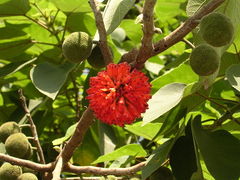Broussonetia
| Broussonetia subsp. var. | ||||||||||||||||||||||||||||||||||||||||||||||||||||||||
|---|---|---|---|---|---|---|---|---|---|---|---|---|---|---|---|---|---|---|---|---|---|---|---|---|---|---|---|---|---|---|---|---|---|---|---|---|---|---|---|---|---|---|---|---|---|---|---|---|---|---|---|---|---|---|---|---|

|
|
| ||||||||||||||||||||||||||||||||||||||||||||||||||||||
| ||||||||||||||||||||||||||||||||||||||||||||||||||||||||
Broussonetia is a genus of four species of trees in the family Moraceae, native to eastern Asia.
| Standard Cyclopedia of Horticulture |
|---|
|
Broussonetia (after T. N. V. Broussonet, a French naturalist). Moraceaae. Ornamental trees or shrubs, grown chiefly for their large handsome foliage. Leaves alternate, petioled, serrate, undivided or lobed: fls. dioecious, apetalous, the staminate in cylindrical, nodding catkins, with 4-parted calyx and 4 stamens, the pistillate in globular heads with a tubular perianth including the stalked ovary; stigma filiform: collective fr., a dense globose head consisting of the persistent perianths and bracts with numerous small 1-seeded drupelets protruding at maturity and orange red.—Three species in E. Asia, and there often cult., the bark being used for paper-making. These are deciduous trees with wide-spreading branches, under culture often shrubby, with rather inconspicuous greenish white flowers. B. papyrifera, the hardier of the two species in cultivation, is fairly hardy as far as north New York. It is usually a small tree with a rather low wide-spreading head and may be used in cities in situations in which small shade trees are wanted, as it stands heat and dust well. It is not particular as to the soil. Propagation is by seeds, sown after maturity or in spring, by greenwood cuttings under glass, or by cuttings of ripened wood, kept in colder climates during the winter in the greenhouse; also by root-cuttings with slight bottom heat and layers. The varieties are also sometimes budded in summer or grafted in early spring on the roots of the type in the greenhouse. Known as paper mulberries.
|
Cultivation
- Do you have cultivation info on this plant? Edit this section!
Propagation
- Do you have propagation info on this plant? Edit this section!
Pests and diseases
- Do you have pest and disease info on this plant? Edit this section!
Species
Broussonetia kaempferi
Broussonetia kazinoki
Broussonetia kurzii
Broussonetia papyrifera
Gallery
If you have a photo of this plant, please upload it! Plus, there may be other photos available for you to add.
-
photo 1
-
photo 2
-
photo 3
References
External links
- w:Broussonetia. Some of the material on this page may be from Wikipedia, under the Creative Commons license.
- Broussonetia QR Code (Size 50, 100, 200, 500)
